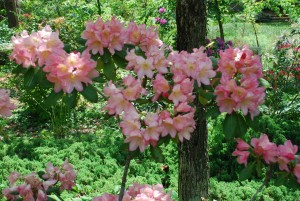Coppicing is a form of renewal pruning because the entire shrub is lopped off to the ground. It is a drastic pruning technique primarily used on shrubs that flower and fruit on new or summer wood, those that flower in late June or later. Coppicing is renewal pruning but is so simple that gardeners is called “no brainer” pruning.
In late February, about 4-5 weeks before spring growth begins, cutback the shrub(s) leaving 3-5 inches of stubble for the new growth to emerge from the adventitious buds near the soil surface.
Coppicing invigorates old shrubs, brightens foliage color and increases fruit size. Overgrown rhododendrons, including deciduous azaleas, plus hollies, pieris and mountain laurels may be coppiced in the fall beginning in late September thru October. It eliminates disease and/or insect- riddled stems and twigs without resorting to pesticides.
Over-grown rhodies should be well-established and healthy; old shrubs in poor vigor will likely not regrow. They may be cut back severely to stumps with no leaves. Healthy plants recover, a year before the plant has much foliage and two or more years before they flower.
Hand clippers, loppers, and saws should be sharp. Do not use string mowers (weed-eaters).


 Posted in
Posted in 
